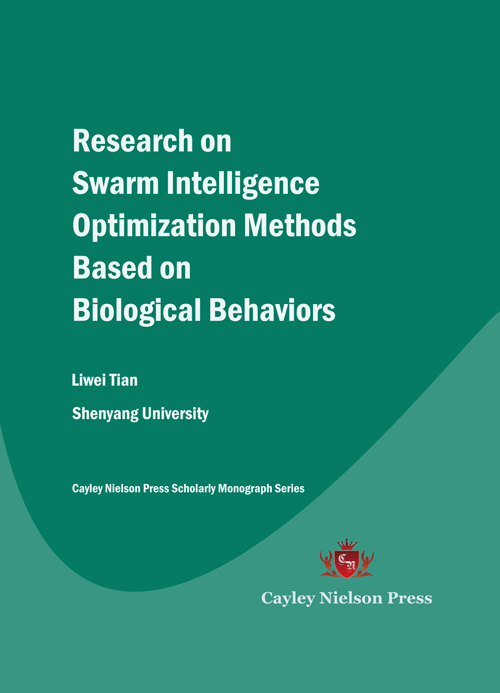
RESEARCH ON SWARM INTELLIGENCE OPTIMIZATION METHODS BASED ON BIOLOGICAL BEHAVIORS

Liwei Tian
Shenyang University
Copyright © 2017 by Cayley Nielson Press, Inc.
ISBN: 978-0-692-85780-9
Cayley Nielson Press Scholarly Monograph Series Book Code No.: 129-8-8
US$93.00
Preface
The author used biological heuristic computing based on foraging behavior, designed the biological modeling, algorithm and the in-depth research on engineering application. This book is the author and the main members of the team to study the crystallization, they are Dr. Yang Liu, Dr. Hongwei Zhao and Dr. Yichuan Shao , etc. At the same time, the authors are supported financially by the Program for New Century Excellent Talents in University of Ministry of Education of China (Project No.NCET-12-1012), Liaoning Distinguished Professor Project (Project No.LR2011035), the China Postdoctoral Science Foundation (Project No.2016M600864), Natural Science Foundation of Liaoning Province under Grand (Project 2015020046), and the Shenyang Science and Technology Project (Project No. F15071200)...........
Contents
Preface.............................................................................................................................................. I
1 Artificial Root Foraging Optimizer algorithm with Hybrid Strategies................ 1
1.1 Introduction........................................................................................................................... 1
1.2 Classical Artificial Root Foraging Model (ARFO)...................................................... 2
1.2.1 Biological basis of plant root growth optimization.............................................. 2
1.2.2 Basic Concepts................................................................................................................... 3
1.2.3 Auxin Regulation.............................................................................................................. 3
1.2.4 The Growth Strategy of Main Root............................................................................. 4
1.2.4.1 Regrowing operator..................................................................................................... 4
1.2.4.2 Branching operator...................................................................................................... 5
1.2.5 Lateral Roots Growth: Random Walking................................................................. 6
1.2.6 Dead Roots Growth: Shrinkage................................................................................... 6
1.3 Hybrid Artificial Root Foraging Optimizer................................................................. 6
1.3.1 Root-to-root Communication....................................................................................... 6
1.3.2 Co-evolution mechanism............................................................................................... 8
1.3.3 The Proposed Algorithm................................................................................................ 9
1.4 Benchmark Test................................................................................................................. 11
1.4.1 Classical Test Functions.............................................................................................. 11
1.4.2 Experimental Setting................................................................................................... 11
1.4.3 Computational Results................................................................................................ 15
1.4.4 Timing Complexity Analysis...................................................................................... 17
1.5 Conclusions.......................................................................................................................... 18
1.6 Acknowledgements.......................................................................................................... 19
2 A Novel Bionic Algorithm Inspired By Plant Root Foraging Behaviors............ 20
2.1 Introduction........................................................................................................................ 20
2.2 Root foraging model for optimization........................................................................ 23
2.2.1 Root foraging model...................................................................................................... 23
2.2.2 Auxin concentration..................................................................................................... 25
2.2.3 Mainroots growth operations.................................................................................... 26
2.2.4 Regrowing operator...................................................................................................... 27
2.2.5 Branching operator....................................................................................................... 29
2.2.6 Lateral-roots growth operation............................................................................... 31
2.2.7 Dead-roots elimination................................................................................................ 32
2.2.8 ARFO algorithm.............................................................................................................. 32
2.3 Root foraging behaviors in ARFO model................................................................... 35
2.3.1 The self-adaptive foraging behavior of roots....................................................... 35
2.3.2 Effect of hydrotropism and gravitropism............................................................. 36
2.3.3 Population evolution of ARFO model..................................................................... 37
2.4 Benchmark test.................................................................................................................. 38
2.4.1 Experimental setup...................................................................................................... 38
2.4.2 Computational results................................................................................................. 44
2.4.2.1 Comparisons with existing results in literature............................................ 44
2.4.2.2 Comparisons with improved variants of bionic algorithms....................... 46
2.4.2.3 Comparisons with classical evolutionary algorithms................................... 52
2.4.3 Timing complexity analysis....................................................................................... 54
2.5 Conclusions.......................................................................................................................... 55
2.6 Acknowledgements.......................................................................................................... 56
3 Multi-Colony Bacterial Foraging Algorithm for Multi-Objective Optimization 57
3.1 Intrduction........................................................................................................................... 57
3.2 Bacterial Foraging Optimization................................................................................. 60
3.3 Multi-objective Multi-colony Bacterial Foraging Optimization....................... 61
3.4 Experimental Study.......................................................................................................... 65
3.5 Conclusion............................................................................................................................ 72
3.6 Acknowledgment............................................................................................................... 75
4 Research on Multiple Particle Swarm Algorithm Based on Bacterial Swarming Behavior 76
4.1 Introduction........................................................................................................................ 76
4.2 Particle Swarm Optimization........................................................................................ 77
4.3 MPSOBS Algorithm........................................................................................................... 78
4.3.1 The Proposed Multiple Particle Swarm Optimization Algorithm Based on Bacterial Swarming 79
4.3.2 The MPSOBS Algorithm Steps................................................................................... 81
4.4 Benchmark Test................................................................................................................. 82
4.4.1 Test Function and Parameters................................................................................. 82
4.4.2 Simulation Results for Benchmark Functions.................................................... 87
4.5 Conclusions.......................................................................................................................... 88
4.6 Acknowledgments............................................................................................................. 88
5 Research on Improved Firefly Optimization Algorithm Based on Cooperative for Clustering 89
5.1 Introduction........................................................................................................................ 89
5.2 Standard AF algorithm.................................................................................................... 91
5.2.1 Basic Firefly Algorithm................................................................................................ 91
5.2.2 The FA Algorithm Steps.............................................................................................. 93
5.3 The cooperative firefly algorithm (CFA)................................................................... 94
5.4 Experimental result......................................................................................................... 97
5.4.1 Benchmark functions................................................................................................... 97
5.4.2 Results for the 10-D problems.................................................................................. 98
5.5 Data clustering experimental results........................................................................ 99
5.6 Conclusion......................................................................................................................... 100
5.7 Acknowledgements:...................................................................................................... 101
6 Study of the Artificial Fish Swarm Algorithm for Hybrid Clustering.............. 102
6.1 Introduction...................................................................................................................... 102
6.2 Optimized AFS algorithm............................................................................................ 104
6.2.1 The original AFS algorithm..................................................................................... 104
6.2.2 The cooperative artificial fish swarm (CAFS) algorithm.............................. 106
6.3. Benchmark tests............................................................................................................ 109
6.3.1 Benchmark functions................................................................................................. 109
6.3.2 Parameter settings..................................................................................................... 110
6.3.3 Simulation results for benchmark functions.................................................... 110
6.3.4 A hybrid clustering algorithm based on CAF clustering model................ 112
6.4 Data clustering experimental results..................................................................... 114
6.4.1 Experiment by simulation data sets.................................................................... 114
6.4.2 Experiment by real data sets.................................................................................. 117
6.5 Conclusion......................................................................................................................... 117
6.6 Acknowledgment............................................................................................................ 118
7. Dynamic Population Artificial Bee Colony Algorithm for Multi-objective Optimal Power Flow 119
7.1 Introduction...................................................................................................................... 119
7.2 The Original Artificial Bee Colony Algorithm....................................................... 122
7.3 The Dynamic Population ABC Algorithm with Life-Cycle Model.................. 126
7.4 The Optimal Problem Formulation.......................................................................... 130
7.5 Results................................................................................................................................ 133
7.6 Conclusion......................................................................................................................... 138
7.7 Acknowledgements........................................................................................................ 139
References................................................................................................................................ 140
Readership
This book should be useful for students, scientists, engineers and professionals working in the areas of optoelectronic packaging, photonic devices, semiconductor technology, materials science, polymer science, electrical and electronics engineering. This book could be used for one semester course on adhesives for photonics packaging designed for both undergraduate and graduate engineering students.
